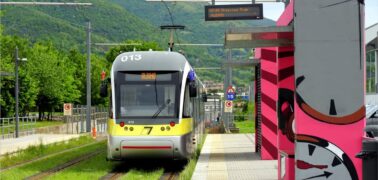The role of sensors and predictive maintenance for digital optimization and improving the efficiency of public transport in Bergamo
Public transport systems are vital for urban mobility, but their efficiency and sustainability require constant improvement. In densely populated urban centers like Bergamo in the alpine Lombardy region of northern Italy, achieving efficient and sustainable public transport is essential. ATB Mobility S.p.A (ATB), a leading provider of public transport services in the area, and Kruch Railway Innovations, a highly specialized supplier of overhead contact line technology, have joined forces under the CE4CE project to transform maintenance processes in Bergamo public transportation system. By introducing cutting-edge sensor-based monitoring systems for predictive maintenance and digitalization, they have created a greener, more resource and cost-effective model of public transport that aligns with circular economy principles and supports Europe's zero-emission goals by 2050.
Shifting from Reactive to Predicive Maintenance based on Data-Collecting Trams
Traditionally, public transport maintenance has relied on reactive and manual practices that are both costly and disruptive. The ATB-Kruch collaboration focuses on predictive maintenance - a proactive approach using big data analysis and artificial intelligence (AI) technologies to preemptively address potential issues in vehicles and infrastructure.
Key innovations include the installation of high-precision sensors, such as GPS devices, accelerometers, and cameras, as well as a rail-certified on-board computer on the roof of a tram and the pantograph. These devices continuously monitor the condition of assets and collect real-time data, which is analyzed by AI algorithms to detect early signs of faults or trends. This setup allows for swift identification of potential issues, minimizing the need for costly routine manual checks, premature repair or adjustment of components before fault and therefore extending the lifespan of vehicles and infrastructure.
In greater detail, using sensors and predictive maintenance to enhance public transportation in Bergamo includes:
- Efficient Data Collection: A tram equipped with high-precision GPS, accelerometers, cameras, and a rail-certified on-board computer acts as a mobile data collection unit. The sensors, installed on the tram roof and the pantograph, enable detailed monitoring during regular service, thus a standard tram gathers useful data while in daily passenger service.
- Real-Time Monitoring: The system provides continuous insights into the condition of vehicles and infrastructure, identifying potential issues before they disrupt service:
◦ Fleet Monitoring: Identifying potential failures such as HVAC malfunctions, emergency braking issues, or wheel vibrations.
◦ Infrastructure Monitoring: Pinpointing problematic areas in rail- and OCL-infrastructure using AI-engine analyses.
- Reduced Maintenance Costs: By detecting faults early, the system prevents major breakdowns and minimizes emergency repair costs. Extended Equipment Life: Predictive maintenance reduces the frequency of premature replacements, contributing to resource conservation.
- AI-Driven Predictive Solutions Outcome: Artificial intelligence analyzes the collected data to predict maintenance needs, determine the optimal time for repairs, reduce downtime and extend the lifespan of assets, thus improving overall operational efficiency.
- Optimized Operations: Improved reliability and resource utilization enhance service delivery for passengers.
- Sustainability Gains: Lower reliance on new parts and vehicles supports circular economy principles, reducing environmental impact.
- Transferability: The methods and insights derived from this pilot aim to be applicable to other cities and broaden its impact.
A Digital Twin – a Circular Energy System Based on Energy-Flow Simulation
ATB and Kruch are also collaborating on optimizing the energy use of Bergamo transport network through deployment of advanced simulation tools. This pilot focuses on creating a "Digital Twin" to model the energy flow of the transport network, enabling energy flow simulations and efficiency validations. The tool is used to analyze and improve operations, and thus reduce energy use and minimize losses of regenerated energy. It also facilitates reliable decision-making by producing clear and trustworthy data of all thinkable variations in infrastructure and operational options to support strategic transport decisions.
Digital solutions benefits
In conclusion, preventive maintenance allows constant monitoring of assets, detecting malfunctions before they turn into major breakdowns. This reduces downtime and emergency repair costs, improving service reliability and optimizing resources efficiency in the long term. This solution is also of paramount importance as for passengers’ and workers’ safety. In addition, digital twins immensely facilitate decision making in public transport operations.
The CE4CE pilots by ATB and Kruch Railway Innovations exemplify the potential of technology in revolutionizing public transport. By integrating sensors, AI, and digital tools, the project partners have created a model that not only enhances efficiency but also promotes sustainability and circularity. This innovative approach underscores the role of smart solutions in building greener, more resilient and future-proof urban transport systems, setting a benchmark for other industries to emulate.
